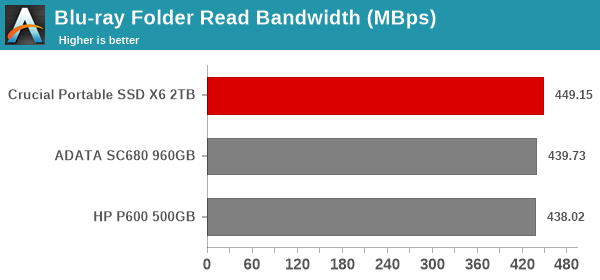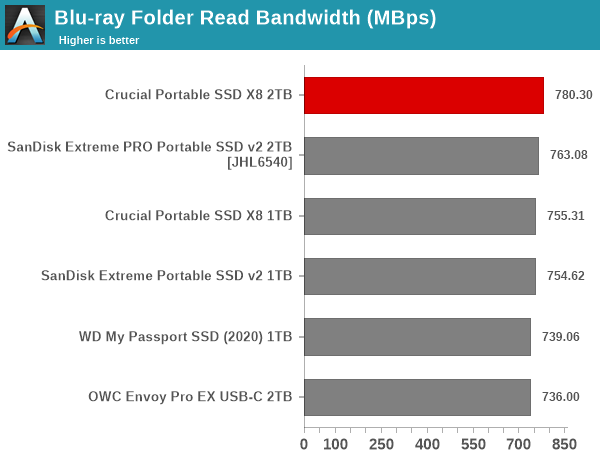Crucial Portable SSD X6 and X8 2TB Review: QLC for Storage On-the-Go
by Ganesh T S on October 21, 2020 8:00 AM ESTAnandTech DAS Suite - Benchmarking for Performance Consistency
Our testing methodology for DAS units takes into consideration the usual use-case for such devices. The most common usage scenario is transfer of large amounts of photos and videos to and from the unit. Other usage scenarios include the use of the DAS as a download or install location for games and importing files directly off the DAS into a multimedia editing program such as Adobe Photoshop. Some users may even opt to boot an OS off an external storage device.
The AnandTech DAS Suite tackles the first use-case. The evaluation involves processing three different workloads:
- Photos: 15.6 GB collection of 4320 photos (RAW as well as JPEGs) in 61 sub-folders
- Videos: 16.1 GB collection of 244 videos (MP4 as well as MOVs) in 6 sub-folders
- BR: 10.7 GB Blu-ray folder structure of the IDT Benchmark Blu-ray
Each workload's data set is first placed in a 25GB RAM drive, and a robocopy command is issued to transfer it to the DAS under test (formatted in NTFS). Upon completion of the transfer (write test), the contents from the DAS are read back into the RAM drive (read test). This process is repeated three times for each workload. Read and write speeds, as well as the time taken to complete each pass are recorded. Bandwidth for each data set is computed as the average of all three passes.

It can be seen that there is no significant gulf in the numbers between the different units for the read workloads. For all practical purposes, the casual user will notice no difference between them in the course of normal usage, though the X6 has a narrow lead. On the writes, we see the X6 getting penalized heavily. Power users may want to dig deeper to understand the limits of each device. To address this concern, we also instrumented our evaluation scheme for determining performance consistency, covered further down in this section.
Moving on to the NVMe-class drives, we again see a similar story being played out. There is not much separating the different drives' numbers, but writes definitely seem to be an Achilles heel for the X8.

The results are not surprising, given the QLC flash in the drive and the fact that Crucial has optimized the drive for read-intensive workloads.
Performance Consistency
Aspects influencing the performance consistency include SLC caching and thermal throttling / firmware caps on access rates to avoid overheating. This is important for power users, as the last thing that they want to see when copying over 100s of GB of data is the transfer rate going down to USB 2.0 speeds.
In addition to tracking the instantaneous read and write speeds of the DAS when processing the AnandTech DAS Suite, the temperature of the drive was also recorded at the beginning and end of the processing. In earlier reviews, we used to track the temperature all through. However, we have observed that SMART read-outs for the temperature in NVMe SSDs using USB 3.2 Gen 2 bridge chips end up negatively affecting the actual transfer rates. To avoid this problem, we have restricted ourselves to recording the temperature at either end of the actual workloads set. The graphs below present the recorded data.
| Performance Consistency and Thermal Characteristics |
 |
The first three sets of writes and reads correspond to the photos suite. A small gap (for the transfer of the video suite from the internal SSD to the RAM drive) is followed by three sets for the video suite. Another small RAM-drive transfer gap is followed by three sets for the Blu-ray folder. An important point to note here is that each of the first three blue and green areas correspond to 15.6 GB of writes and reads respectively. The X6 might not be the fastest drive when it comes to the writes, but, the consisntency maintained from run to run with both reads and writes is impressive. The temperature rise is only 2C after almost 250GB of traffic. The HP P600, though, fares better in both the thermal design and transfer rates perspective.
The same tests on the NVMe-class drives yielded the following results.
| Performance Consistency and Thermal Characteristics |
 |
The graphs for the X8 1TB and 2TB versions present interesting comparison points - In the 1TB version, we see writes with big hiccups in as soon as the second pass of the first workload. For the 2TB version, this doesn't happen until the third pass of the second workload. Devices such as the OWC Envoy PRO EX USB-C and the WD My Passport SSD maintain better consistency all through.










22 Comments
View All Comments
mostlyfishy - Wednesday, October 21, 2020 - link
UASP and TRIM support mean these look good for a boot device on the Raspberry Pi 4s!Meteor2 - Monday, October 26, 2020 - link
Why would you pair a $35 SBC with a $300 SSD?MartenKL - Wednesday, October 21, 2020 - link
No Samsung T7 or X5 in the comparison?ganeshts - Wednesday, October 21, 2020 - link
X5 is a Thunderbolt 3 SSD - so I don't consider it here in the USB 3.2 Gen 2 category.For T7, we only reviewed the 1TB capacity, so the only non-2TB ones are either the same X8 family or the SSDs launched within the last two months. FWIW, T7 didn't impress us too much: https://www.anandtech.com/show/16120/sandisk-extre...
Duncan Macdonald - Wednesday, October 21, 2020 - link
What is the rated write endurance ? External SSDs are often used to transfer large amounts of data between machines - in this use case the TBW rating is important.wrkingclass_hero - Wednesday, October 21, 2020 - link
Probably the most important spec... if it can only be filled 600 times that's a serious issue.RSAUser - Thursday, October 22, 2020 - link
If it's not the main OS drive, it will probably last a lot longer, most SSD wear is the small temp files of the OS rather than file transfers.Most drives are rated at hundreds of TB, standards are something like 100TB for every 250GB, and I doubt anyone would hit 4000 cycles within a few years, and by that point it should play nicely and be read only.
What I am more worried about is how long it can store data without being powered up, I have a couple of external HDD's that I haven't plugged in in years.
Meteor2 - Monday, October 26, 2020 - link
I too would like to know how stable SSDs are unpowered long-term.TheinsanegamerN - Monday, October 26, 2020 - link
SSD and long term don’t belong in the same sentence. Guaranteed data integrity for NAND flash memory is measured in weeks. Hard drives are measured in months, but can typically go years.Our treasury found this out the hard way when the handful of laptops they bought with SSDs in them all failed to boot after sitting for 2 months. SSDs were fine, but the data integrity was not.
If you want long term cold storage and tape is not an option stick with writable blu rays or external HDDs and plug them in once every few months
MrCommunistGen - Thursday, October 22, 2020 - link
For what it is worth, CrystalDiskInfo has had a bunch of updates since v8.3.2. There's a chance that the latest version (currently v8.8.9) might detect TRIM support on the X8.